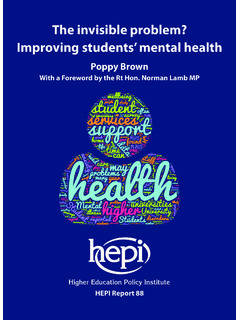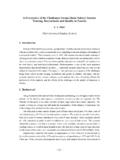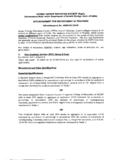Transcription of Boys to Men: The underachievement of young men …
1 Boys to Men: The underachievement of young men in higher education and how to start tackling itNick Hillman and Nicholas RobinsonWith a Foreword by Mary Curnock Cook HEPI Report 84 About the AuthorsNick Hillman is the Director of HEPI. Earlier in his career, he taught in a boys school and two girls schools. He is the father of one boy and one girl and the governor of a voluntary-controlled school, as well as a member of the Advisory Group of the Office for Fair Robinson was a HEPI Visiting Researcher in 2015. He has an Economics degree from the University of Melbourne and has worked on higher education for the Grattan Institute, an Australian think Mary Curnock Cook, Chief Executive of UCASHEPI s scan across the evidence and possible solutions to the growing imbalance in educational achievement of boys is enormously useful and highlights just how complex this topic the challenges presented requires expertise in a vast array of subjects.
2 Neurology, psychology, pedagogy, culture, social science, anthropology, education, assessment, geography, economics, humanity, feminism, politics, history and behavioural science come to think of it, it has the makings of a superb liberal arts / science the evidence is compelling. Boys are performing worse than girls across primary, secondary and higher education, not to mention apprenticeships, and the situation is getting worse. On current trends, the gap between rich and poor will be eclipsed by the gap between males and females within a decade.
3 UCAS s latest End of Cycle report shows the entry rate for men increased by much less than for women in 2015, widening the gap between the sexes to a record percentage points at age 18, meaning young women are now 35 per cent more likely to go to university than men. If this differential growth carries on unchecked, then girls born this year will be 75 per cent more likely to go to university than their male Joanna Williams wrote recently in Times Higher Education: Imagine for a minute what would happen if these figures were reversed. I have no doubt there would be panicked calls for an 2 Boys to Meninquiry into what was causing such dramatic gender inequality.
4 There would be demands for better outreach programmes, publicity campaigns and positive discrimination to get girls into higher commentators, including me, have suggested that the dominance of women in the school workforce may play a role in boys underperformance relative to girls. While this report does not find evidence to support the theory, I remain instinctively convinced that, as in any other area of life, gender imbalance will itself generate further imbalance. Just as the performance of boys at GCSE has declined relative to girls, so the proportion of female teachers has increased.
5 Up until 1993, male teachers in secondary education were in the majority. In the UCAS Teacher Training admissions (UTT) service today, more women apply and they also achieve higher offer and acceptance rates. This results in five women placed through UTT for every two men nearly 20,000 women against 8,500 men last higher education sector and the Department for Business, Innovation and Skills have started to tackle the problem. The recent higher education green paper and the Office for Fair Access have signalled clearly that they want to see improved participation by boys, particularly those from disadvantaged backgrounds.
6 They can see that overall inequalities in access to higher education simply cannot be successfully reduced without addressing lower participation by young men, which contributes perhaps the single largest inequality in the system. The higher education sector can and should take action but it is inescapable that boys lower attainment levels earlier in their education need to be addressed , the recent Department for Education white paper, Education, Excellence, Everywhere makes no mention of the chronic under performance of boys in primary and secondary education.
7 As the white paper title indicates, the Department is more exercised by geographical inequality in education outcomes and the document is peppered with maps to underline the point. There may be pockets of poor standards of education across the country, but the underperformance of boys is pervasive throughout social strata, geographies and report is compelling reading as it peels the onion of male underperformance in higher education, and it proposes some imaginative interventions. But its real value is in highlighting the sheer scale of the problem.
8 To me, it suggests the need for a joined-up approach across the Department for Education and the Department for Business, Innovation and Skills, across the country, across primary, secondary and higher education and across society. A national determination to tackle the problem is to 1 Executive Summary 6 Introduction 10 The issue 16 Causes 27 Recommendations 36 Conclusion 496 Boys to MenExecutive Summary After centuries of inequality in UK higher education benefiting men, there has been a reversal over the past three decades.
9 A lower proportion of entrants to UK higher education institutions are male than ever before and they make up less than one-half of the total. Other developed countries have undergone a similar shift. Male underachievement is not seen only in the figures for entry but also in non-continuation (drop-out) rates and degree performance statistics. Men still outperform women in some of the most prestigious areas such as entry to the highest-tariff institutions, to Science and Engineering courses and to research degrees. Moreover, on some indicators, men have better employment outcomes.
10 Six months after leaving higher education, women are more likely to be in work but men are more likely to be in professional occupations. Among those with jobs, men also earn higher incomes on average. But the overall picture suggests young men are not performing as well in higher education as young women. This is storing up problems for the future. Recognising the challenge does not excuse the past under-representation of women. Nor does it excuse the challenges posed today to female students by lad culture and to female staff by obstacle-laden promotion routes.









